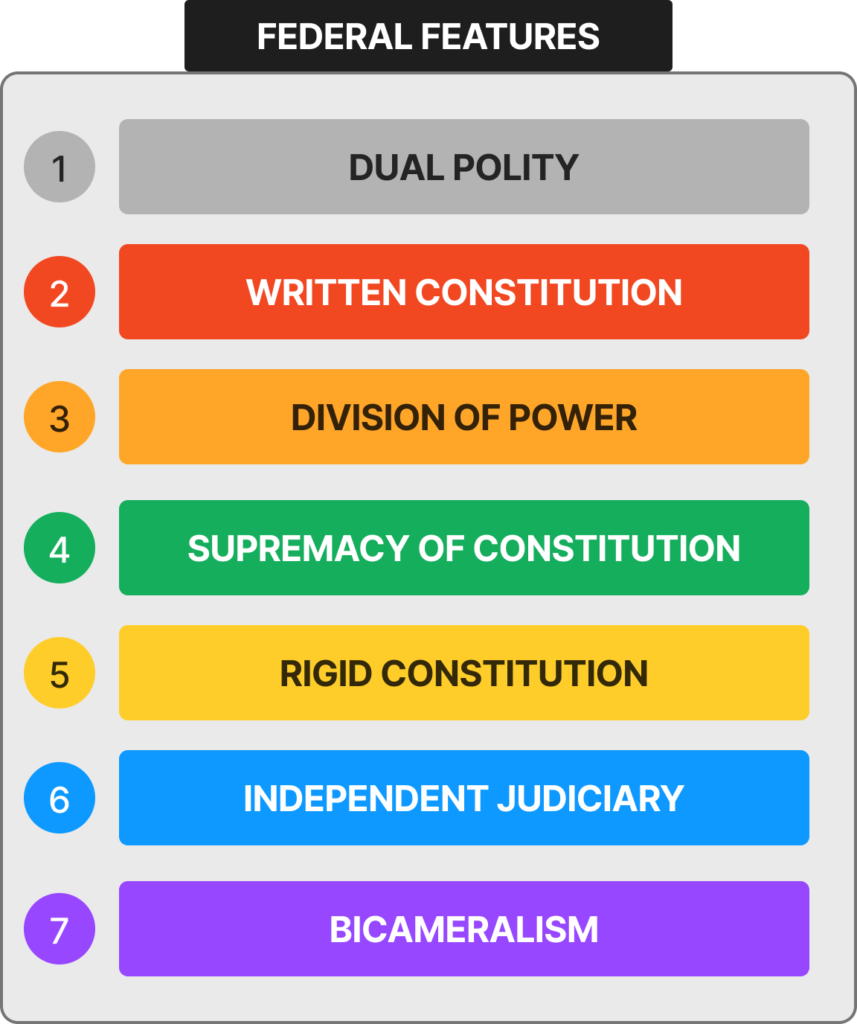Introduction
- In a federal system, national and local levels of government share authority; in a unitary system, a single central government is in charge of everything.
- India is a federal country. But not once does the Constitution mention the word “federation.” Instead, it says that India is a “Union of States.”


Federal features of Indian Constitution
- Division of Powers: The Seventh Schedule of the Constitution has three subject lists that show how the two arms of government are split into their respective domains.
- Written Constitution: The Indian Constitution is a written document. Every provision of the Constitution has been discussed in great detail and is officially expressed in writing.
- Supremacy of the Constitution.
- Supreme judiciary: The Supreme Court of India is the highest court of justice in India.
- Bi-cameral legislation: The Indian Parliament, i.e., the legislature has two houses – the Lok Sabha and the Rajya Sabha.
Unitary or Non-Federal Features
- Single Constitution: There are no separate constitutions for the States. In a true federation, there are separate constitutions for the union and the States.
- Centre’s control over States: The States have to respect the laws made by the central government and cannot make any law on matters on which there is already a central law.
- Rajya Sabha does not represent the States equality: In a true federation, the upper house of the legislature has equal representation from the constituting units or the States.
- Existence of States depends on the Centre: The boundary of a State can be changed by created out of the existing States.
- Single citizenship: In a true federal state, citizens are given dual citizenship. In India however, the citizens enjoy single citizenship, i.e., Indian citizenship or citizenship of the country as a whole.
- Unified judiciary: India has a unified or integrated judicial system. The Supreme Court is the highest court of justice in the country and all other subordinate courts are under it.
- Proclamation of emergency: When emergency is declared, the Union or Central governments become all powerful and the State governments come under the total control of it. The State governments lose their autonomy.
- In legislative matters, the Union Parliament is very powerful. It has not only exclusive control over the Union list and the residuary powers, but it has also dominance over the Concurrent list and the State list. This is of important for uniformity of laws in the country.
- In administrative matters also, the Central government has been made more powerful than the States. The State governments have to work under the supervision and control of the Central government. The States should exercise its executive powers in accordance with the laws made by the Parliament. It can control the State governments by directing them to take necessary steps for proper running of administration. If the State fails to work properly or according to the Constitution, it can impose President’s rule there under Article 356 and take over its (the State’s) administration.
- Financial matters, the President of India has the power to make alterations in the distribution of revenues earned from income-tax between the centre and the States. The Centre has also the power to grant loans and grant-in-aid to the State governments. The Comptroller and Auditor General India and the Finance Commission of India which are the central agencies also have control over the State finances.
India, as KC Wheare said, is neither proper unitary nor federal but quasi-federal in nature as it has features of both.
| UNITARY SYSTEM | FEDERAL SYSTEM |
|---|---|
| Inside a unitary government, on either hand, a central government is indeed the nation’s highest controlling body | The federal government permits national & local governments to function autonomously within their own areas |
| A unitary government is indeed a separate system of government in which the central government already has powers | Whereas, a federal government is a dual form of government in which powers are shared between both the national government & local governments |
| A unitary government being a form of governance wherein the central ruling body, or central government, wields all powers | The federal government defines a form of governance that consists of two tiers of government: national & state or local |
| In a unitary state, this central government is indeed the highest authority of powers | The national government, and also municipal administrations, are permitted to operate autonomously within their own territories |
| The majority of countries in the world now have a unitary government. Japan, the United Kingdom, France, Italy, and other countries have such a unitary government | Federal governments exist in countries such as the United States, Australia, Russia, and Canada |
Conclusion
In 1983, the Sarkaria Commission emphasized co-operative federalism in India. It is a fact that India has a strong Central government but it should not always try to interfere in the matters of the States. Both the governments should respect one another’s power or authority and work harmoniously.